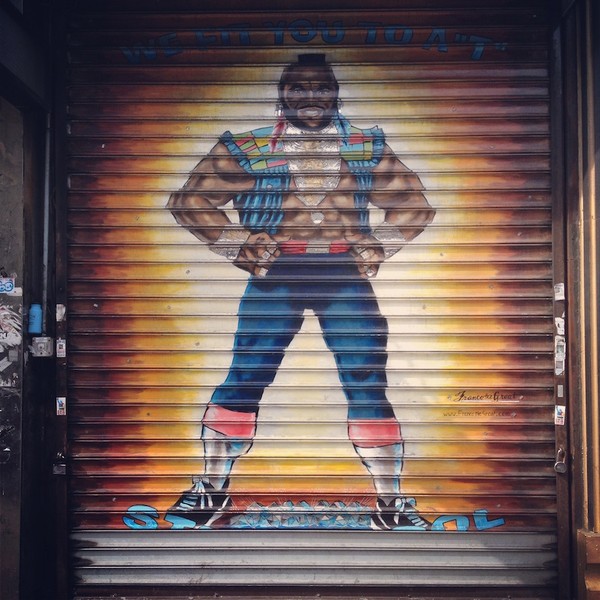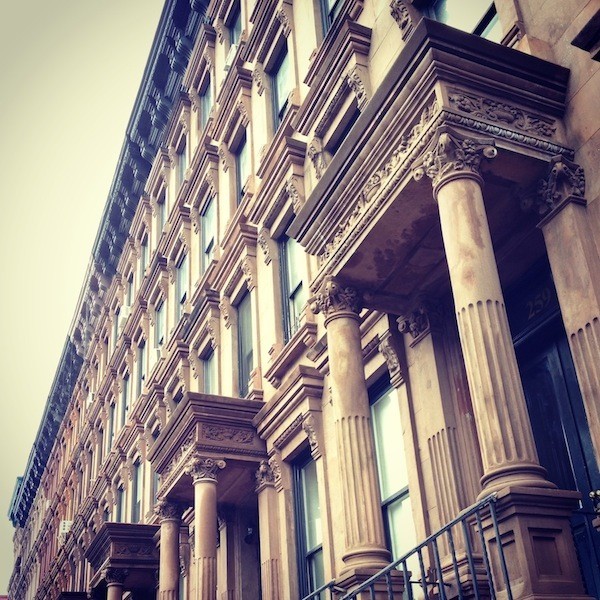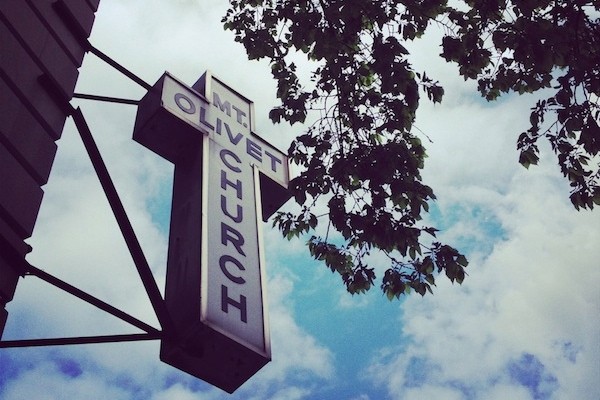Summer in Harlem: A Walking and Eating Tour
 All Photos by Kate Donnelly.
All Photos by Kate Donnelly.
"Drop Me Off in Harlem," went the 1933 Duke Ellington song, but there's no better time to go than this summer, for The Classical Theatre of Harlem's July performance of A Midsummer Night's Dream, the Charlie Parker Jazz Festival in August, and Art Crawl Harlem tours. Kate Donnelly stops in for a visit.
HARLEM – Harlem maintains an old-world, New York feel, blending cool street hustle and sophistication with distinct architecture. Its rich cultural background began with Dutch origins and was enhanced by Italian and Jewish immigrants who sauntered into the haven of the legendary Harlem Renaissance. The result is a mix of Latin, Italian, and Southern Caribbean influences.
Move down 125th Street, and you'll find savvily dressed preachers, fedora hats, Kangol berets, pick-up chess games, sneaker shops for miles, CD peddlers, and local artists selling Harlem ware. In the morning before the stores open, the roll-down metal gates are the canvases for Franco the Great's dazzling murals of such figures as Martin Luther King, Malcolm X, and Mr. T and jubilant scenes from Harlem's jazz clubs and fabled halls.



The avenues are wide and sprawling, with low-rise buildings giving way to an unobstructed expanse of sky. The broad, tree-lined blocks are filled with beautiful, stately brownstones. The churches, barbershops, wig shops, and African braiding shops have terrific old signage. Conversations and cat-calling on the street are unrivaled. Outside, young kids rebound basketballs on gated storefronts, while summer-ready women strut with sheer confidence. It's a magic beat, a blend of the modern with homages to a culturally fabled past.
WHERE TO EAT
Harlem's cultural diversity includes culinary options from around the globe.

First things first: Don't miss Red Rooster. The great lunchtime $25 prix-fix menu provides generous portions of carrot-ginger soup and honey-mustard salmon (see photo) washed down with a cold bottle of Haitian Prestige beer. Other crowd pleasers include Helga's meatballs and the infamous fried yardbird. Happy hour on Friday is all the rage. A seat at the bar makes for stellar people watching: a mix of scholarly, professorial bow-ties, fashion-forward locals, and blue-collar patrons. Order a plate of spicy wings or Rooster nuts and nurse the spicy Obama-tini with crushed pepper-infused aqauvit, pineapple, lime, grapefruit, and Angostura bitters. If you're on the nocturnal beat, Ginny's Superclub downstairs kicks up its heels with rhythm and late night dancing.
French mainstay Chez Lucienne is a great place for lunch. Ask for an outside patio seat and watch the Lenox Street passerbys. Cedric Bistro is a charming, laid-back corner spot for mussels, burgers, and sauteed jerk chicken.
Jado Sushi churns out fresh, authentic Japanese fare, with special mentions to fried oysters with panko and glazed short ribs, while the small storefront Jin Ramen is a prized treat of Tokyo-style fare. Kick everything off with the pork buns, then move to fresh, delicious noodles paired with a flat wooden spoon. Get your ramen on — char sou pork melts in your mouth, and everything washes nicely with a cold Sapporo.

Throw down at a communal table at Bier and sip a pint of Bronx Pale Ale coupled with a Bavarian pretzel and sausage, either smoked kielbasa or chicken and ouille sausage. Their hand-cut fries are also winners. Harlem Public is a perfect spot for watching a Yankees game or meeting up with pals for a relaxed brunch of sloppy joes, fish tacos, and a wide range of craft brews.
Harlem Shake is a relative newbie, a throwback diner with tin ceilings and a celebrity wall of fame. They serve steak burgers, hot dogs, and old-fashioned shakes for kids and adults. And although Sylvia may still be the Queen of Harlem, Amy Ruth's is the stop for soul food. The dish they call the Rev. Al Sharpton is a full-on culinary assault of waffles and dark meat chicken.
Lenox Coffee is a low-lit, cozy spot which brews Stumptow, plays great music, and allows laptops. Il Cafe Latte is a smaller joint for caffeinated sips. Add something sweet, like fresh and yummy cookies, from Levain Bakery.
For late-night spirits, head to the dimly lit, velvet-curtained, speakeasy-esque 67 Orange Street for hand-crafted cocktails shaken by dapper men.
WHAT TO DO
The Studio Museum Harlem showcases emerging and established African-American artists and has an extensive archive from the Harlem Renaissance photographer James VanDerZee. Don't miss the bookstore for its stellar selection of local and historic postcards and books like the spectacular photobooks Harlem: A Century in Images and Gordon Parks: A Harlem Family. Art Crawl Harlem's amazing tours through local galleries may be the best way to see art uptown. LeRone Wilson is one to watch.
Marcus Garvey Park is home to basketball courts, spray showers, playgrounds, and culture. There's always something good at Harlem Stage, which features visionary artists of color in music, dance, performance, film, and education.
From July 13-30, The Classical Theatre of Harlem (CTH) is presenting performances of A Midsummer Night's Dream at Richard Rodgers Amphitheater in Marcus Garvey Park. From August 23-25, the park's outdoor Amphitheater hosts the Charlie Parker Jazz Festival.

A row of 1885 Italianate brownstones between West 122nd and West 123rd Streets.
Strivers' Row is a masterpiece of the architectural glory: three rows of townhouses on West 138th and 139th Streets (between Adam Clayton Powell Jr. Blvd. and Frederick Douglass Blvd.). This elegant development quickly became associated with great affluence. The Neo-Italian and Georgian influences resemble a West Village-like setup with stately homes and beautiful trees. Many of the gates still bear original late 1800s signage: "Private Road, Walk Your Horses."
Harlem has an impressive and abundant number of churches and worship houses, many of which were converted from old movie houses. Churchgoing women are dressed to the nines and always in lovely hats. Roam past the cool architectural exteriors of Absynninian Church, All Saints Church, Mt. Olivet Baptist Church, and The Commandment Keepers Ethiopian Hebrew Congregation, an African-American synagogue that occupies an 1890 neo-Renaissance building. Greater Refuge Temple is a pastel-colored, mid-century wonder in a former cinema. If you want to attend a Sunday gospel choir service (a regular Harlem tourist attraction), go to Abyssinian Baptist Church, New Mount Zion Baptist Church, Mount Neboh Baptist Church, or Greater Refuge Temple. (Here's a Harlem church directory.)

Mt. Olive Church
The ghosts of jazz past are everywhere in Harlem. Breeze by the old haunts, like the famous Apollo Theatre. Check out free music at Showman's Jazz Club and add yourself to the list of jazz aficionados awaiting the revival of Minton's Playhouse, where Dizzy Gillespie, Thelonious Monk, and Count Basie once played. Stroll past the homes of Langston Hughes at 20 East 127th Street; Billie Holiday at 108 West 139th Street; and Duke Ellington, Joe Louis, and Lena Horne at 555 Edgecombe Avenue.
WHERE TO STAY
There are not many charming and boutiquey hotel options around, but these are the good ones:
Aloft Harlem Hotel – The little sister of the W Hotels brand.
Sugar Hill Harlem Inn – A green bed-and-breakfast on West 141st Street with two rooms, two studios, and one suite all named for prominent Harlem artists. They also have a four-bedroom Victorian townhouse a few blocks away.
The Harlem Renaissance House – Three suites that blend modern and traditional styles in a Stanford White-designed townhouse along Strivers' Row.
Harlem Grand B&B – Lovely and old-fashioned in a classic brownstone on West 122nd St.
The Harlem Flophouse – Four bedrooms with in-room sinks but no private bathrooms.
FOR YOUR BEDSIDE TABLE
Brush up on your history by starting at the beginning with Jonathan Gill's Harlem. American Gangster is Hollywood's gritty-glam look at Frank Lucas and 1970's Harlem. Jazz: A film by Ken Burns is a crash course for the beginner to the aficionado. Yes, Chef is Marcus Samuelson's love letter to growing pains, moving on, and food. The refined and informative Harlem Bespoke keeps locals up on current openings and events.
MORE ON FATHOM
How Locals Spend a Sunday: Marcus Samuelsson's Harlem
New York Guide
Brooklyn Guide
Inset photos, from top: salmon at Red Rooster; Bier.
